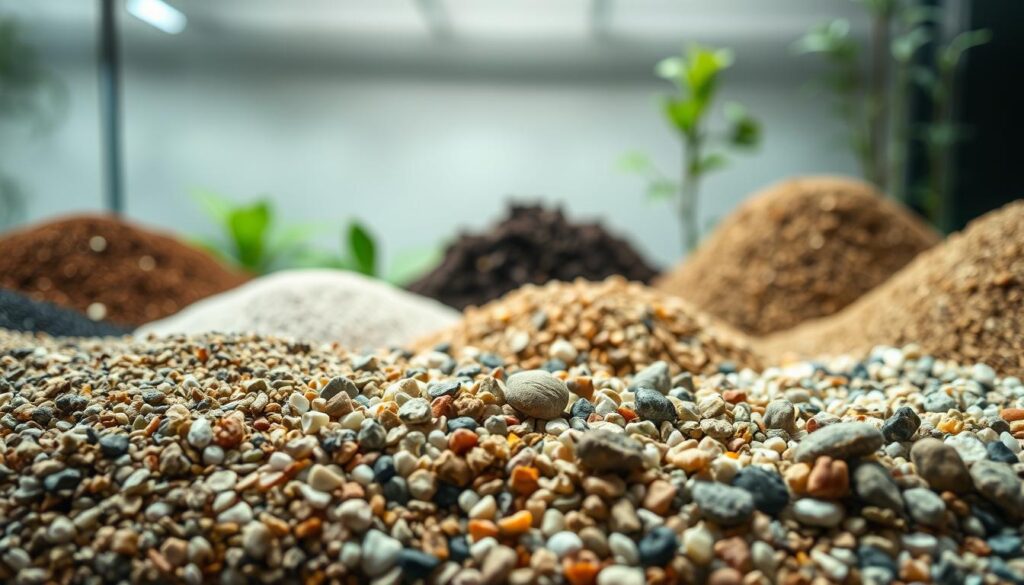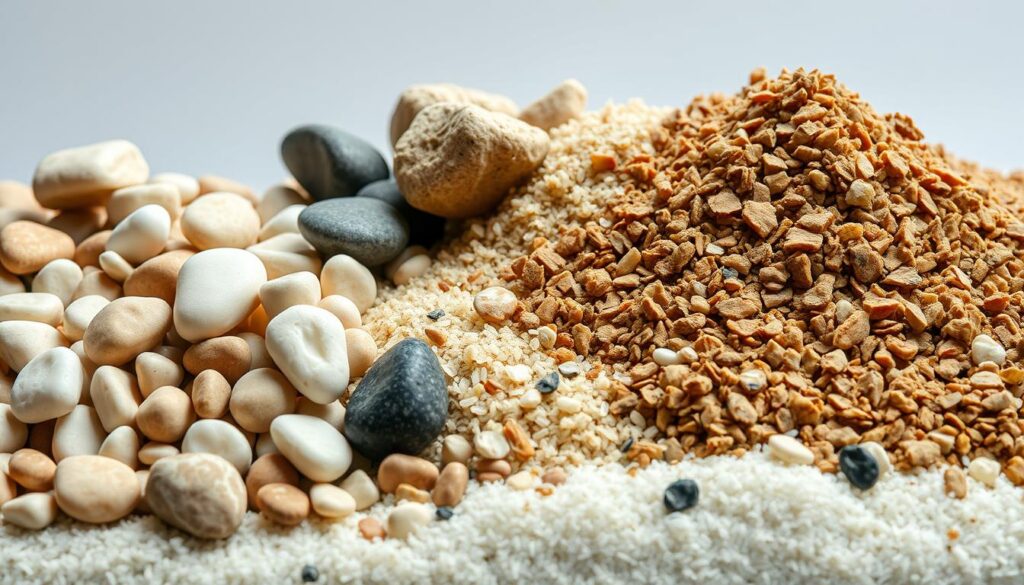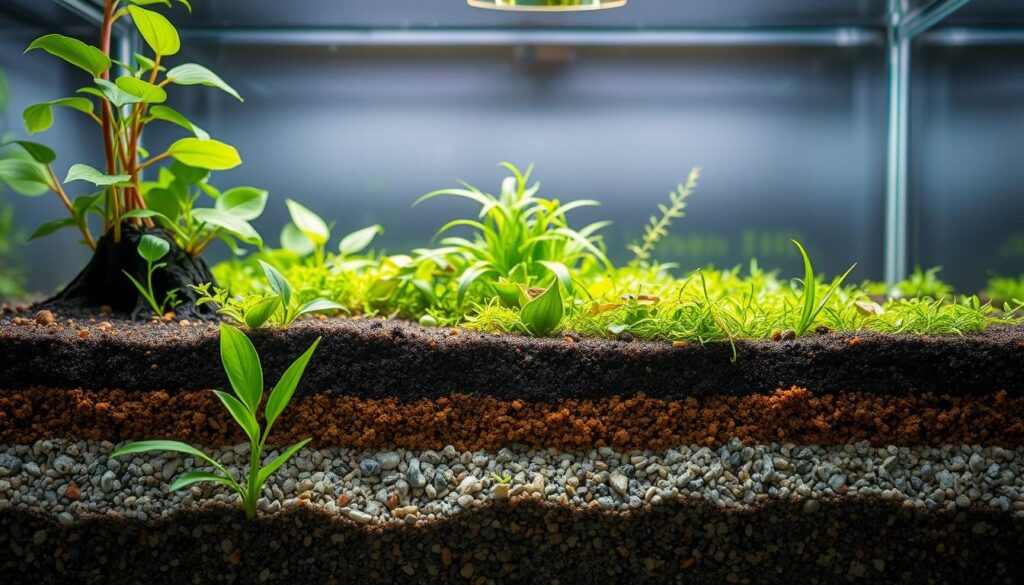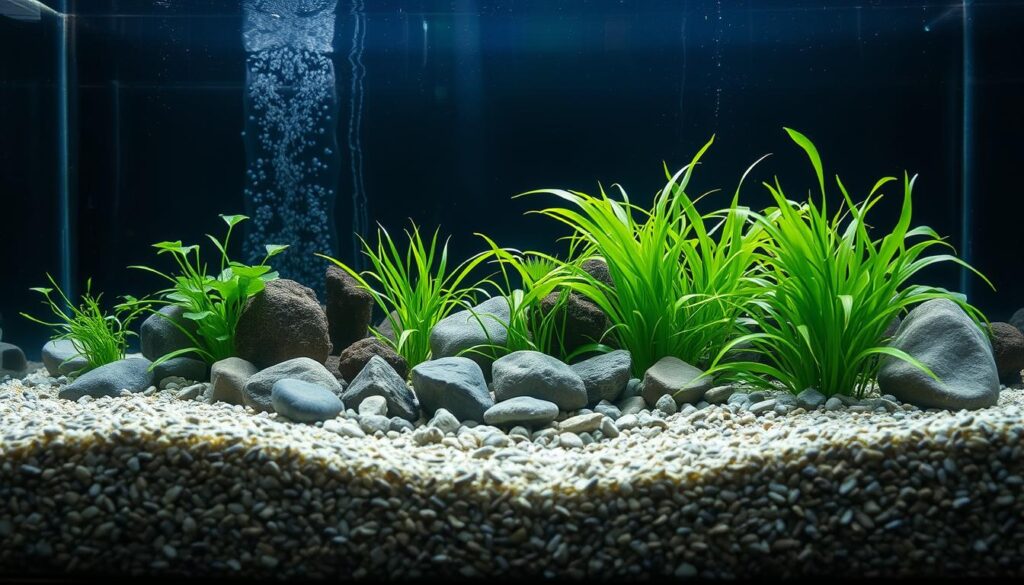When setting up a lush, green tank, selecting the best substrate for planted aquarium setups is a make-or-break decision. The right substrate supports strong root development, delivers nutrients, and maintains water quality—while the wrong one can stunt plant growth and throw off the tank’s balance.
With so many options on the market, it’s easy to get overwhelmed. In this guide, we’ll explore the most recommended substrates, what makes them effective, and which ones you might want to avoid to keep your aquatic plants thriving.
A quality aquarium substrate for plants is the base of a healthy aquarium. It gives plants the nutrients and support they need.
So, what makes a great substrate? Is it the color, the texture, or something else? Let’s explore the world of substrates together!
Key Takeaways
- Understand the importance of substrate for planted aquariums
- Learn how to choose the right substrate for your tank
- Discover the benefits of a quality aquarium substrate
- Explore different types of substrates for planted tanks
- Get tips on maintaining a healthy substrate
Understanding Aquarium Substrate Basics
The substrate in your planted aquarium is like the soil in your garden. It’s where the magic happens, and your plants’ roots grow strong! You might wonder, what’s the big deal about substrate? It’s not just about looks; the substrate is key to your plants’ health and your aquarium’s balance.
What Is Substrate and Why It Matters for Plants
The substrate is the material at the bottom of your aquarium. It provides a home for beneficial bacteria, supports plant roots, and affects water chemistry. For plants, a good substrate is like nutrient-rich soil. It promotes healthy root growth and lush plants. The ideal planted aquarium substrate should hold nutrients, support beneficial bacteria, and be easy to care for.
How Substrate Affects Plant Growth and Aquarium Health
A good substrate can change your aquarium’s ecosystem. It helps plants grow by giving them essential nutrients and a stable root environment. It also keeps water quality high by hosting beneficial bacteria that break down waste. Choosing the recommended substrate for live plants is crucial for a healthy aquarium.
The Best Substrate for Planted Aquarium: Types and Options
Choosing the right substrate is key for a healthy planted aquarium. It gives plants the nutrients they need and supports beneficial bacteria. It also makes your tank look great.
Nutrient-Rich Substrates vs. Inert Substrates
Nutrient-rich substrates, like aqua soil, are packed with nutrients for plants. They support healthy growth. Inert substrates, like gravel and sand, don’t have nutrients but can still help plants grow with fertilizers.
- Nutrient-rich substrates: great for plants needing lots of nutrients, but can be messy.
- Inert substrates: versatile, easy to clean, and work well with many fertilizers.

Single-Layer vs. Multi-Layer Substrate Systems
Single-layer systems use one substrate type in the tank. Multi-layer systems use different substrates in layers. This way, you can get the best of both worlds, like nutrient-rich bottom layers and easy-to-clean top layers.
Benefits of multi-layer systems:
- Optimized nutrient delivery for plants.
- Improved water circulation and filtration.
- Aesthetic flexibility.
Natural vs. Manufactured Substrate Materials
Natural substrates, like soil or sand, can be used but need extra care. Manufactured substrates are made for aquariums. They provide the best conditions for plants and water quality.
Knowing about different substrates helps you choose the best for your planted aquarium.
Key Factors to Consider When Choosing Aquarium Substrate
Your aquarium’s substrate is the base of your underwater world. Choosing the right one is crucial for success! When picking the best substrate for your planted aquarium, consider several factors. This ensures a thriving environment for your plants and fish.
Plant Species Requirements
Different plants need different substrates. For example, Anacharis and Cabomba can grow well in many substrates. But, plants like Bucephalandra need a nutrient-rich substrate. Knowing your plants’ needs is key to picking the best substrate for planted aquarium setups.
Water Chemistry Considerations
The substrate you choose affects your aquarium’s water chemistry. Some substrates change the pH or release nutrients. This can impact water parameters. For instance, some substrates buffer pH, while others promote plant growth but need careful monitoring. Choosing a quality aquarium substrate for plants means thinking about its effect on water chemistry.
Aesthetic Preferences and Tank Design
The look of your substrate is also important. The color, texture, and depth can greatly change your aquarium’s appearance. Whether you prefer a natural, sandy bottom or a deep, rich soil, your substrate choice defines your tank’s design. Think about how the substrate will enhance your substrate for live plants and overall aquascaping vision.

Top Commercial Substrates for Thriving Planted Tanks
Choosing the right commercial substrate is key for a successful planted tank. There are many options, but picking one that supports plant growth and tank health is crucial.
Read Also Top Centerpiece Fish for Freshwater Community Aquarium
ADA Aqua Soil Amazonia
ADA Aqua Soil Amazonia is a favorite among aquarists. It offers the best conditions for plants to grow, with a structure that helps roots develop well. This substrate makes plants grow strong and vibrant. An aquarist shared, “ADA Aqua Soil Amazonia has transformed my tank, making my plants thrive.”

Fluval Stratum
Fluval Stratum is a top pick for planted tanks. It’s made from natural volcanic material, giving plants a nutrient-rich home. It’s great for root growth and preventing nutrient shortages. Its unique mix supports a healthy aquarium ecosystem.
Seachem Flourite
Seachem Flourite is a trusted substrate in the aquarium world. It’s a nutrient-rich clay-based option that promotes healthy plant growth. It keeps the pH stable, creating a better environment for your fish. An experienced aquarist said, “Seachem Flourite has been my choice for years, and it always delivers.”
CaribSea Eco-Complete
CaribSea Eco-Complete is packed with nutrients for plant growth and tank health. It’s a mix of natural materials, including calcium and iron. This substrate is great for root growth and vibrant plant colors. Its wide range of nutrients makes it a top choice for planted tanks.
Tropica Aquarium Soil
Tropica Aquarium Soil is a premium option for planted tanks. It’s rich in nutrients, supporting healthy plant growth and color. Tropica Aquarium Soil creates a perfect environment for plants to thrive. Choosing it gives your plants the best chance to flourish.
Budget-Friendly Substrate Options That Deliver Results
Creating a thriving planted aquarium doesn’t have to be expensive. There are many affordable substrate options. You can have a lush underwater garden without spending too much on substrate. Let’s look at some cost-effective alternatives that work well for your planted tank.
Organic Potting Soil Capped with Sand/Gravel
One smart way to save money is to use organic potting soil as the base. Then, add a layer of sand or gravel on top. This mix offers nutrients for your plants and looks good too. The potting soil gives your plants what they need, while the sand or gravel keeps the water clear.
Benefits: It’s rich in nutrients, affordable, and you can choose how it looks. Start with a layer of potting soil, then add a thin layer of sand or gravel. This way, you save money and can pick the look you like.
Safe DIY Substrate Mixtures
Another way to save is by making your own DIY substrate. You can mix different ingredients to meet your plants’ needs. A common mix is topsoil, peat, perlite, or vermiculite for better drainage. It’s important to sterilize your ingredients to avoid contamination. You can do this by baking or microwaving the soil to kill harmful pathogens.
Tips for success: Know what your plants need, sterilize your ingredients, and add a decorative layer. With a bit of creativity, you can make a substrate that supports healthy plant growth without spending a lot.
Specialized Substrates for Different Aquarium Types
Setting up a planted aquarium isn’t a one-size-fits-all job. Each type of aquarium has its own needs. The right substrate can make a big difference in creating a thriving underwater world.
Substrates for Low-Tech Planted Tanks
Low-tech tanks don’t need fancy substrates. But, they still need something that supports plant growth. Seachem Flourite or CaribSea Eco-Complete are great choices. They provide the nutrients plants need without costing too much.
Substrates for High-Tech CO2-Injected Systems
High-tech tanks with CO2 need substrates that support fast plant growth. ADA Aqua Soil Amazonia or Tropica Aquarium Soil are perfect. They’re made to work well with CO2, helping plants grow strong and healthy.
Substrates for Aquascaping Styles (Iwagumi, Dutch, Nature)
Aquascaping calls for substrates that match your design. Iwagumi styles often use sand or fine gravel. Dutch tanks might have colorful substrates for a pop of color. Nature-style tanks benefit from Fluval Stratum for a natural look.

Choosing the right substrate for your aquarium type is key. It sets you on the path to a stunning underwater world that will thrive for years.
Substrate Compatibility with Aquarium Inhabitants
Setting up a planted aquarium means picking the right substrate. It should help plants grow and be safe for your fish. The right choice can make your aquarium a thriving home for both plants and animals.

Fish-Friendly Substrate Choices
It’s important to choose a fish-friendly substrate to keep your fish safe. Stay away from sharp or coarse substrates that can hurt them. Instead, go for smooth, rounded gravel or sand that’s gentle on their bodies.
Some good options include play sand, pool filter sand, and Fluval’s Plant Stratum. These are designed to be safe for your fish.
Substrates for Tanks with Bottom-Dwellers and Burrowers
If you have bottom-dwellers like loaches or catfish, you need a special substrate. They need a deep layer of sand or a mix of sand and fine gravel to dig and burrow. Seachem Flourite and CaribSea Eco-Complete are great for this. They support plant growth and are comfortable for bottom-dwellers.
Choosing the right substrate is key to a happy aquarium. It’s all about finding a balance between your plants and animals. This way, your aquarium will be healthy and beautiful.
How to Prepare and Install Substrate Properly
Preparing your aquarium substrate is key to a thriving underwater garden! A good substrate gives your plants the nutrients they need. This ensures a healthy and balanced ecosystem.
Washing and Preparing Different Substrate Types
It’s important to wash your substrate before putting it in. This removes dust or debris that could cloud your water. For substrates like ADA Aqua Soil or Tropica Aquarium Soil, just rinse them gently. This keeps the important nutrients in.
Inert substrates might need a deeper rinse. This helps remove any leftover manufacturing residue.
Adding Substrate Additives and Root Tabs
Adding substrate additives or root tabs can help your plants grow. These products give your plants the nutrients they need for healthy growth. Just remember to follow the instructions to avoid over-fertilizing.
Step-by-Step Substrate Installation Guide
Here’s a simple guide to installing your substrate:
- Start by rinsing your substrate as needed.
- Make a gentle slope for easy planting and to stop debris.
- Put in any root tabs or additives as the instructions say.
- Slowly add the substrate to your tank to avoid clouding the water.
By following these steps, you’ll create a beautiful and thriving planted aquarium!
Maintaining and Upgrading Your Planted Tank Substrate
A well-maintained substrate is key to a thriving underwater garden! As your planted tank grows, it’s vital to focus on long-term care. This ensures your aquatic plants stay healthy and vibrant.
Long-Term Substrate Care and Nutrient Replenishment
Over time, your substrate can lose essential nutrients. Regular replenishment is crucial! Use root tabs or add fertilizers directly to the substrate. Always check your substrate’s condition and adjust your care as needed.
If your plants are struggling, it might be time for a nutrient boost! Consider adding a substrate supplement or changing your fertilization schedule.
How to Safely Change Substrate in an Established Tank
Changing substrate in an established tank can seem daunting. But sometimes, it’s necessary for your tank’s health. Start by preparing a new substrate that matches your current one.
Begin by siphoning out some of the old substrate carefully. Make sure not to harm your plants’ roots or upset the tank’s balance. Slowly add the new substrate, watching for any stress signs in your tank’s inhabitants.
Remember, upgrading your substrate takes patience! Take your time, and don’t hesitate to ask for advice if needed.
Conclusion: Creating Your Underwater Garden Paradise
Now that you’ve learned about aquarium substrates, it’s time to make your underwater garden come alive! Choose the right substrate and follow the best practices for planted tanks. You’ll be on your way to a thriving aquatic ecosystem.
The secret to a stunning planted aquarium is in the details. From picking the perfect substrate to keeping it clean. Whether you’re new or experienced, we’ve got you covered. Use what you’ve learned to create a breathtaking underwater scene that will amaze everyone.
So, what are you waiting for? Dive into the world of planted aquariums and start making your own underwater masterpiece today! With the right substrate and a bit of creativity, you’ll soon have a lush, vibrant aquatic paradise. Follow these guidelines to create a beautiful planted aquarium that shows off your style and love for the aquatic world.

